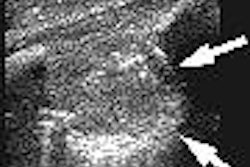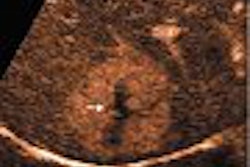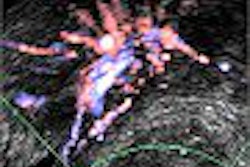Ultrasonography can be an alternative to radiography in diagnosing nasal fractures, according to researchers from Germany. The study team found no statistically significant difference between the two modalities in assessing the nasal pyramid for fractures.
The researchers from the department of otorhinolaryngology at University Hospital in Muenster, Germany, found radiography was better for diagnosing nasal dorsum fractures and US was better for lateral nasal wall fractures. In the final assessment, both had equivalent diagnostic performance for the nasal pyramid.
The prospective single-blinded study investigated 63 patients with clinical signs of nasal bone fracture using a clinical exam, radiography, and US.
Two otorhinolaryngologists independently assessed two radiographs and three US images for each patient. The radiographs consisted of a lateral image of the nasal bone focused on the nasal dorsum and an occipitomental image for assessing the lateral nasal walls. US images were obtained for the right lateral nasal wall, left lateral nasal wall, and nasal dorsum.
For comparing the radiographic and US diagnosis with the clinical diagnosis, the results of both readers were pooled into one because statistical analysis using the K test showed good correspondence in most comparisons between the readers' findings.
For the purpose of the study, the radiographs and US images were assessed separately and in random order. The US and radiography results were each separately matched with the clinical or surgical diagnosis, and considered to be correct if they matched.
Nasal fracture was diagnosed in 42 of the 63 patients. At least one fracture of the lateral wall was diagnosed in all 42 patients, and a fracture line of the nasal dorsum was diagnosed in 40 patients. Thirty-six of the 42 patients underwent reduction of nasal fracture.
"Assessment of the lateral nasal walls revealed US was statistically superior (p = 0.04) to radiography. In contrast, assessment of the nasal dorsum showed radiography to be statistically superior (p = 0.01) to US. Assessment of the nasal pyramid revealed no statistical difference between radiography and US (p = 0.91)," the researchers reported.
|
|||||||||||||||||||||||||
However, US had difficulty in assessing a slightly dislocated fracture of the nasal bone. "The present study revealed a significant advantage of radiography with respect to the nasal dorsum," the researchers wrote.
"By contrast ... assessment of the lateral nasal wall was significantly better when based on ultrasound examination than on the occipitomental radiograph. Specifically, the swelling of soft tissue led to difficulties in analyzing the radiograph, while this problem did not occur in the ultrasound examination except in rare cases of open bone fracture," they stated.
The US exam was done using a 10-MHz US head (EUP-L34T, 3 x 1.4 cm, Hitachi Medical Corp, Tokyo) with an ultrasound device (EUB-525RS, Hitachi Medical Corp). The 10-MHz head "is the most commonly used ultrasound device in the examination of the head and neck in daily routine," and was selected for the study for this reason, the researchers wrote in the Archives of Otolaryngology -- Head &Neck Surgery (May 2005, Vol. 131: 5, pp. 434-440).
The size of the head was a disadvantage in examining children with a small nose, but it enabled the nasal dorsum and the lateral nasal wall to be visualized in one image in adult patients. "This was advantageous in the retrospective analysis of nasal trauma and especially in cases with potential legal consequences, in which good documentation of the fracture is important," they stated.
In instances in which the nasal dorsum is swollen or the surface of the nose is irregular because of trauma, the group recommended a water-filled rubber glove to optimize performance of the US examination.
The group's results are similar to those reported in an earlier study (HNO, June 1996, Vol. 44:6, pp. 324-328) in which US showed a sensitivity of 83% for nasal fractures if clinical diagnosis was used as the reference, and a sensitivity of 94% if radiography was used as the reference, according to the authors.
"In the final assessment of the nasal pyramid, radiography and ultrasonography were considered equivalent methods, although ultrasonography showed slight advantages in the descriptive statistical analysis. Therefore, ultrasonography can be considered an alternative to radiography, with equivalent diagnostic performance in assessing nasal pyramid fractures," the group concluded.
By N. Shivapriya
AuntMinnie.com contributing writer
July 27 2005
Related Reading
Hospital finds cheaper facial imaging with CT versus x-ray, September 22, 2004
Copyright © 2005 AuntMinnie.com



















